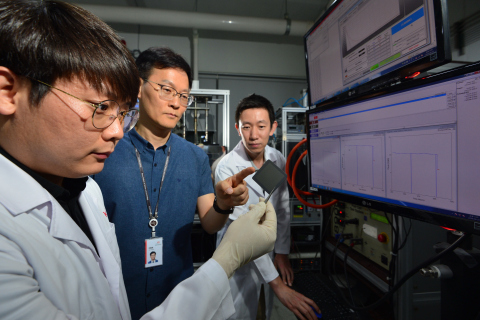KIST: Eco-Friendly Hydrogen Fuel Cell Takes a Step towards Commercialization
Ministry of science and ICT stated that Dr. Jong-Ho Lee and Dr. Ho-Il Ji at the high temperature energy material research center developed a Protonic Ceramic Fuel Cell, PCFC that can be commercialized, with the help of Professor Dong Wook Shin from Hanyang University. The research results were published in October on Nature Energy (IF:46.859, JCR top 0.515%), an international energy technology journal. Fuel cells are devices that transform chemical energy directly into electrical energy, and has huge development potential as a future energy conversion device with its lack of waste production.
This press release features multimedia. View the full release here: https://www.businesswire.com/news/home/20181107005366/en/

KIST researchers conducting a test to check PCFC performance ratings. (Photo: Business Wire)
Solid oxide fuel cells (SOFCs) are especially receiving a lot of attention with its high energy conversion efficiency and ability to use various types of fuel, and PCFCs especially are standing in the spotlight with expectation of high performance at lower operating temperature compared to conventional SOFCs. However, difficulty in fabrication of thin and dense electrolyte on a porous electrode which mainly originated from the refractory nature of proton conducting electrolyte hinders commercialization of PCFCs.
The KIST research team partnered with the Hanyang University research team to enhance the performance of PCFCs while simultaneously developing a method to produce the cells on a commercialized scale. During development, the teams systematically methodized a process to enable the familiarization of the electrolytes within the electrolyte-electrode assembly and also reduced the production process temperature, which is a world first. The entire process also utilized micro-wave procedure and screen-printing method which are adequate for the actual production processes owing to their high economic efficiency.
The PCFC consisting of an electrolyte layer with a thickness of 5μm, 5/100,000th of 1cm, and a surface area of 5x5cm2 showed 12 times enhancement on performance relative to the previous report. Since the performance was taken in real application conditions, it provided clear evidence for the possibility of the commercialization of the fuel cell, and thus has received a lot of recognition from specialists and industries.
Dr. Lee stated that “The research results can be applied to more than just simple energy production, but also to fuel production and conservation as well as other various relative areas and industries. It will be the stepping stone for the improvement of future renewable energy availability.”
View source version on businesswire.com: https://www.businesswire.com/news/home/20181107005366/en/




